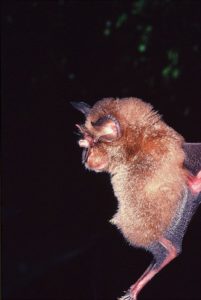
We want to thank Blogger Rachael on her 51st blog post this year! She’s featured almost 30 species. Thank you Rachael. We’re looking forward to what you discover in 2019! Hi everyone! I hope you all had a very Merry Christmas and are enjoying your winter holidays. I am enjoying my school vacation very much. Since this is my last blog post of the year, I thought it would be nice to look back at all that happened this year. It’s been a rather long year that began with the Winter Olympics in Pyeong Chang, South Korea and is ending with a tsunami and volcanic eruptions in Indonesia. In between, there were hurricanes, wild fires, earthquakes, and more volcanic eruptions. It sounds like a bad year, but there were also some good things that happened. Over the summer, 12 members of a youth soccer team and their coach were rescued from an underground cave in Thailand. Not only did we have the Winter Olympics this year, but we also came together for the World Cup in July. And, in what is possibly the cutest news story of the year, an adult male koala needed to be rescued for the third time in his life when he got his head stuck in a fence in South Australia. And now, since the people of Indonesia are having such a difficult time, I thought I’d research another Indonesian bat. I found an adorable leaf nosed bat called the Arcuate horseshoe bat. They were discovered by Wilhelm Peters in 1871. He gave them the name “arcuatus” which is Latin for “curved”. Peters never said why he decided to name these bats curved, but some scientists believe that it is due to the curve of their nose. These adorable furry critters live in Southeast Asia, […]
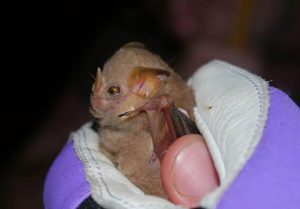
Hi everyone! I hope you all had a good week! I had a fantastic week because it was the last week of school before winter break! I am going to enjoy the next two weeks by sleeping late and celebrating the holidays with my family. Since it is the Christmas season, I decided to write this week’s blog on a bat that, in my opinion, looks very similar to the Grinch. It took some looking but I found an adorable critter called the Little White-shouldered bat. These bats have leaf shaped noses that resemble the Grinch’s famous smirk. They have brownish-gray fur with striking white shoulders that give them their name. They also have yellow eyes that look so cool! Little White-shouldered bats have big, almost see-through, ears that look adorable atop their small heads! Not a lot of information has been collected on what these bats eat, but scientists have looked at the teeth of Little White-shouldered bats and concluded that they probably eat insects like most bats in America. They live in Central America into Brazil, Guyana, Venezuela, Trinidad, and Bonaire Island. These bats like to roost in tropical forests near streams. They are typically found in evergreen forests. If you want read more about Little White-shoulder bats you can do so here. I also found a very cute story about how bats saved Christmas. If you would like to read it, you can find it here: I hope everyone has a very Merry Christmas!

Hi everyone! I hope you all had a good week! I am excited that Winter Break is coming soon. Sadly, I have to wait another week to get my vacation. I found a very interesting article on bats regarding their hunting strategies and how they vary from species to species. An international group of biologists set out to compare five different bat species. They studied a total of 94 bats. The scientists fixed each bat with a tiny recording device to look at their flight path and listen to what noises they made. The researchers used this information to discover where the bats found food and whether or not other bats were nearby. They looked at 2 species of bats that hunted socially for prey, such as swarms of insects or fish, who are found in unpredictable locations. Then they looked at three species that foraged for food alone and whose prey was always at the same location and could be found easily. The bats that foraged alone ate things like fruit and tried to separate themselves from others. If other bats were around it could create a competition for food. The bats that foraged together were much more social. The researchers found that these bats tended to eavesdrop on the other bats feeding calls and were constantly communicating with others of their own species to see if they had found food. When one bat found food to eat, others followed close behind and hunted behind them. In order to test if the bats were truly hunting together for the food, the scientists placed three recording devices around where the bats hunted. One recording device played white noise, one played a normal bat call, and one played a bat’s feeding call. When the bats heard the white noise, they mainly ignored the recording. When they heard the normal call they began to investigate, […]
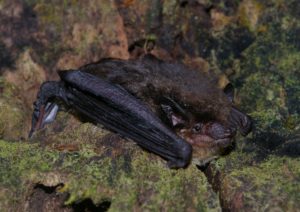
Hi everyone! I hope you all had a good week! I’m excited because it’s almost Christmas! I found a very interesting article about a group of scientists in Uruguay who are creating a special AI algorithm that will help in identifying bats flying around! This is important because bats in South America speak different dialects than the same species in North America. So, the databases in use in North America don’t work in Uruguay or the rest of South America. This new algorithm will be able to pick up a bat’s call through a microphone and determine which species it is. This algorithm was first created to help scientists learn which bats were flying into windmills. This information could then be used to work with wind farm operators to help protect bats. Studies have shown that more than 40 bat species are affected by windmills and almost 300 mass bat death events have occurred due to wind turbine blades. Until now, scientists needed to catch bats flying in an area in order to identify them. With this algorithm, the very difficult and time-consuming task of catching a bat is no longer necessary. In addition to being used to help scientists protect bats from wind turbines, this algorithm could be used to identify unknown bat species. Hopefully the use of this algorithm will help scientists locate a bat that has been believed extinct in Uruguay for 50 years. If you would like to read more about this study, you can find information here. .
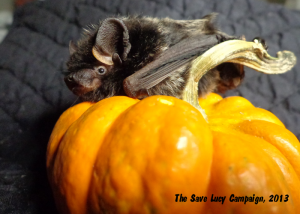
Hi everyone! I hope you all had a good week. My week started with my dog’s birthday. We’ve been celebrating and spoiling her all week. Yesterday, there was an earthquake in Alaska. I decided to research an Alaskan bat. I found an adorable bat called the Silver-haired bat. The Silver-haired bat lives in the temperate rain forests of Southeast Alaska. Actually, these bats live throughout the United States, including Save Lucy’s state of Virginia, and southern Canada. The Silver-haired bat has black fur all over its body except for their ears. The black fur on their back has silver tips which makes the bat look like it has a back full of silver fur. These bats also have short round and hairless ears that lay close to their head. Like all bats in North America, these bats are insectivores. They love to munch on an assortment of meals such as flies, moths, mosquitoes, beetles, ants, and crickets. Silver-haired bats like to roost near water in areas near lakes, ponds, and streams. They roost here because they hunt close to the water where there is an abundance of tasty bugs for them to crunch on. They roost in tree foliage, under loose bark, and sometimes buildings. They like to hibernate under loose bark and in tree hollows. If you would like to learn more about the Silver-haired bat, you can read about them here and here.
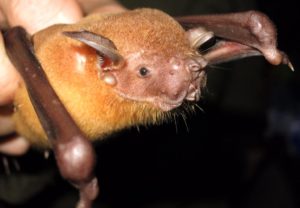
Hi everyone! I hope you all had a good week! I did because we got a snow day on Wednesday. We got about an inch of snow before it started sleeting. The wonderful people in charge decided that it wasn’t safe for us to go to school. It was wonderful! It was glorious! And then to add to the gloriousness, we got a 2 hour delay the next day! It was great! I hope everyone else enjoyed their snow days as much as I did. I was looking up interesting bat species and I found one called the Bulldog Bat. I think this bat is really cute. Of course, all bats are cute, but I might be a little biased toward this one because it looks a little bit like my pug. The name Bulldog Bat actually is used to describe two different species of bats that live in Central and South America. These bats hunt over water. As their name suggests, these bats have big lips and a flat squarish muzzle that makes them look like a bulldog. They also have cheek pouches that they use to store food in. These bats have very large hind feet with hooked claws. They use their claws to catch prey from the surface of the water. The Lesser Bulldog Bat eats mostly insects. The Greater Bulldog Bat eats fish. Once they catch their prey, they chew their food and store it in their cheek pouches to finish later. The Lesser Bulldog Bat uses echolocation to find its prey. The Greater Bulldog Bat skims the top of the water echolocating on ripples made by the fish. One problem the Bulldog Bat has with hunting over water is that they get wet wings, however these bats actually have an oily substance coating their wings […]
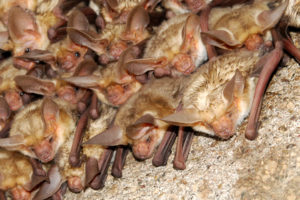
Hi everyone! I hope you all had a good week! People in California have been having a hard time. They are having some really bad wildfires again. This week’s blog is dedicated to all the people in California affected by these fires. I found a handsome bat that lives in California called the Pallid Bat. I think I have written about this bat before, but it is so cute that I thought it would be nice to read about them again. This bat also lives in British Columbia all the way down to central Mexico. They also live as far east as western Texas, Oklahoma, and southern Kansas. The Pallid Bat is found in deserts, rocky places, oak and pine forests, and farmland. These bats like to roost in caves, rock crevices, mines, hollow trees, and buildings. These adorable bats have light brown fur with pale white fur on their stomachs. They have special glands on their face, much like the glands of skunks. The glands produce an odor just like a skunk’s too. They use this odor to defend themselves. The Pallid Bat has an amazing adaptation. Unlike most bats, the Pallid Bat does not eat their food while flying. They land and then eat! They swoop down on their pray, and then carry their meal to a safe perch where they can eat it. These bats feast on crickets, beetles, grasshoppers, and scorpions. Most North American bats aren’t big enough to safely take down a scorpion, but these fluff balls are actually immune to a scorpion’s sting. [And they pollinate cactus! Researchers noted that pallid bats netted near columnar cactus were often covered in pollen, but it was assumed they were picking up pollen while gleaning for insects. Researchers studying the plant interactions of another bat, the nectar […]
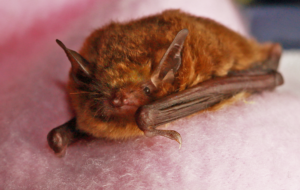
Hi everyone! I hope you all had a good week. I had a rough ending to my week because I sprained my ankle very badly. I was viciously attacked by a tree root and my ankle did not appreciate it. Even though I am wounded, I think I had a better week than a lot of people in the southeastern part of the country. Hurricane Michael tore through the area last week and people there are still suffering. This week, I researched another Florida bat and I think I found a cute one. The Southeastern Myotis is adorable! It looks a lot like Little Brown Bats. They have gray-brown to orange-brown fur and are lighter on their stomachs. Their fur, however, is shorter, and thicker, than that of the Little Brown Bat. Southeastern Myotis live in many other places than Florida. They also live in Southern Illinois and Indiana, Oklahoma, western Tennessee, Arkansas, Northeastern Texas, the southern part of North Carolina, the Ohio River Valley of Kentucky, and coastal regions northward into Virginia. The Southeastern Myotis likes to roost in caves, hollow trees, buildings, and bridges. They eat insects, such as mosquitoes, flies, small beetles, and moths. If you would like to read more about the Southeastern Myotis bat, you can find information here. Also, I would like to remind everyone of the big batty event at the US Botanic Gardens in Washington, DC next weekend. The Bat Bonanza Event will be Saturday, October 27 and will begin at 10 AM. This is always a very fun event full of all kinds of batty fun. I plan on being there and, best of all, Mrs. Sturges, Save Lucy’s President, will be there with some live bats. If you are in the DC area, I hope you’ll stop by.
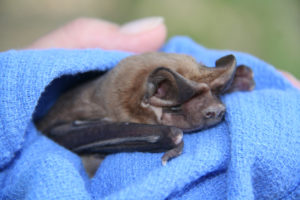
Hi everyone! I hope you all had a good week. Mine was fun because I have a friend visiting, so I’ve been doing a lot of sightseeing. There was a hurricane in the southeastern United States this week. The state of Florida was hit very hard. This week’s blog is dedicated to everyone affected by Hurricane Michael, not only in Florida, but also in Alabama, Georgia, North and South Carolina, and Virginia. I did a little bit of research and discovered that Florida’s largest bat is the Florida bonneted bat. I wrote about this bat a couple of years ago, but I thought it was worth refreshing everyone’s memories on this adorable bat. This bat is listed as endangered by the USFWS and is believed to be the rarest bat in the world. The Florida bonneted bat is large with a long tail membrane. It can be 6.5 inches long with a wingspan of 20 inches. Its ears join at the base. The bats’ fur is black, brown, gray, or cinnamon brown. Not much is known about this bat because it is so rare. They only live in a few counties in south Florida and only a few nursery roosts have been found. Loss of habitat is the Florida bonneted bats’ greatest threat. Habitat loss for this species comes in the form of human destruction of its roosting sites as well as natural disasters such as hurricanes. If you would like to read more about the Florida bonneted bat, you can find information here. In other batty news, there will be a bat event at Huntley Meadows Park in Alexandria, VA tonight at 7:00 PM. I am going to try to make it. Mrs. Sturges will definitely be there with some of our bat friends. If you are in the […]
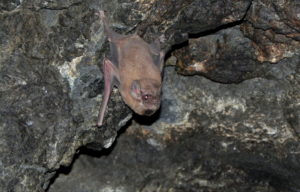
Hi everyone! I hope you all had a good week. My week had a sad start because the Nature Fest in Herndon was cancelled because of the rain. It rained pretty much all week, but I think we are supposed to have a sunny weekend. There was another earthquake in Indonesia on Friday. And then after the earthquake there was a tsunami. I would like to dedicate this week’s blog to the people of Indonesia. My thoughts are with you all while you recover from these events. I researched Indonesian bats and I found an absolutely adorable one! It is called the Black-bearded tomb bat. They have a face that reminds me of a shrew with a beard. Its face points outward and they have big round ears on top of their head. Their fur is brown with a little bit of gray and sometimes even red. The dense fur covers most of their body, but it stops before it covers their face. I think this makes their fur look slightly mane-like. The male Black-bearded tomb bats have seasonal black-ish brown beards that they grow to attract mates. Black-bearded tomb bats are found in a variety of places including Indonesia, China, India, Malaysia, Singapore, Vietnam, and Thailand. They roost in rainforests, woodlands, and abandoned buildings. They roost near where they can find their favorite foods. They eat insects like many other bats, but they also enjoy munching on fruit. If you would like to learn more about these bats, you can find information here and here.









